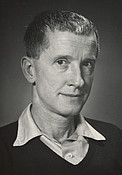Profiles of Leading Women Scientists on AcademiaNet.
Members
List of Members | Expert Search
Search among the members of the Leopoldina for experts in specific fields or research topics.

Max Delbrück
Nobel Prize in Physiology or Medicine 1969
| Year of election: | 1963 |
| Section: | Biochemistry and Biophysics |
| City: | Pasadena, CA |
| Country: | USA |
CV Max Delbrück - German (PDF)
Research
Max Delbrück was a German-American biophysicist. In 1969, together with Alfred Day Hershey and Salvador Luria, he was awarded the Nobel Prize for Physiology or Medicine for his discoveries on the reproduction mechanism and genetic structure of viruses. In the field of physics, Delbrück scattering is named after him. The term describes the deflection of a photon by the electromagnetic field of an atomic nucleus that has been experimentally proven.
Career
Max Delbrück began studying astronomy in 1924. Later he added physics and mathematics. His education proceeded at different academic locations: he began in Tübingen in 1924, went on to Berlin in 1925, from there to Bonn in the same year and eventually back to Berlin. From 1926, he studied in Göttingen, where he received his PhD in theoretical physics in 1929 under Max Born, who would later be awarded the Nobel Prize in Physics. The subject of his dissertation on quantum mechanics was covalent bonds. Years abroad followed where Delbrück met Niels Bohr in Copenhagen and Wolfgang Pauli in Zurich.
From 1932, he worked at the Kaiser Wilhelm Institute for Chemistry in Berlin, where he was an assistant to Lise Meitner and Otto Hahn, among others. At the suggestion of Niels Bohr, he began to turn to problems in biology during this time. As early as 1935, he published a paper on gene mutations with geneticist Nikolaj Timoféev-Ressovskij and physicist Karl Günther Zimmer.
In 1937, he went to the United States of America on a Rockefeller Foundation scholarship. In autumn 1939, he received a professorship in physics at Vanderbilt University in Nashville/Tennessee. There, working with the Italian biophysicist Salvador F. Luria and in close contact with Alfred Hershey, he made discoveries in the fieldsof bacterial genetics and phage genetics. Phages are viruses that can attack and infect bacteria. This work was to earn the three scientists the Nobel Prize in Physiology or Medicine in 1969.
In 1947, Max Delbrück received a call to the California Institute of Technology in Pasadena, where he remained with short interruptions until 1976. From 1961 to 1963, Max Delbrück worked in Cologne, Germany, where he built up the Institute of Genetics at the University of Cologne. In 1969, he helped establish the Faculty of Biology at the University of Konstanz, Germany.
By the early 1950s, he had eventually turned his attention to an entirely new field of research with his investigations into signal conversion mechanisms using a fungus called Phycomyces.
Max Delbrück always strove for interdisciplinary cooperation between different natural science disciplines throughout his scientific work. He is also credited with introducing and establishing mathematical models in biology.
Nobel Prize
Max Delbrück focused his research on so-called phages during his time in the USA. These viruses are able to attack and infect bacteria. Together with the Italian-American Salvador Luria and the American Alfred Hershey, Delbrück proved that bacteriophages mutate spontaneously, making them resistant to viral infection.
In addition, the three geneticists deciphered the structure of the reproduction mechanism of bacteriophages. Through this work, bacteriophages were finally introduced into genetic research as the simplest biological objects. This in turn enabled a new methodological approach to biology. Max Delbrück has since been regarded as a co-founder of molecular biology.
Delbrück's work on phage genetics later contributed to a better understanding of the development of cholera epidemics. Bacteriophages are the actual cause of this dangerous infectious disease. Previously, it was assumed that the disease was only triggered by a bacterium called Vibrio cholerae.
Honours and Memberships
Max Delbrück received numerous other awards, including the Kimber Medal for Genetics from the US National Academy of Science (1964), the Mendel Medal from the German Academy of Sciences Leopoldina (1967) and the Louisa Gross-Horwitz Prize from Columbia University (1969). Delbrück was also a member of numerous scientific associations, including the German Academy of Sciences Leopoldina (1963), the US National Academy of Science (1949), the American Academy of Arts and Sciences (1959), the Royal Danish Academy (1960) and the Royal Society in London (1967).
Numerous universities also awarded him honorary doctorates, including Copenhagen (1962), Chicago (1967), Heidelberg (1968), Harvard (1971) and Göttingen (1981).
Person
Max Delbrück was born in Berlin, DE, on 4 September 1906, the youngest of seven children of historian Hans Delbrück and his wife Carolina Thiersch, a granddaughter of the chemist Justus von Liebig. His uncle was the chemist Max Delbrück.
On 2 August 1941, he married Mary Adeline Bruce. The couple had four children: Jonathan (1947), Nicola (1949), Tobias (1960) and Ludina (1962). In 1945, Delbrück became an American citizen. He was the brother-in-law of the theologian Dietrich Bonhoeffer.
Max Delbrück passed away on 9 March 1981 in Pasadena, California, USA.

